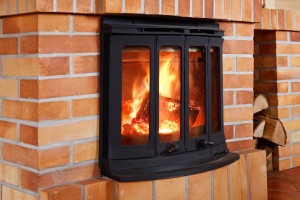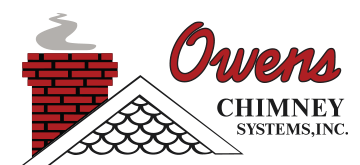When you have an older traditional fireplace, you are not heating your home as effectively or as efficiently as you could be with a new fireplace insert. No matter whether you choose wood, pellet, or gas as the fuel source, a new fireplace insert will help you save money on your heating costs this winter. While you cannot depend on an insert to heat your home, the supplemental heat it provides can save you up to 40 percent on your utility costs. Owens Chimney Systems would like to tell you more about the pros and cons of each fuel type of fireplace insert to help you decide how you will convert your old fireplace into a more efficient heating appliance.
Wood-Burning Inserts 
Similar to a wood-burning stove, this type of fireplace insert is a firebox that Owens Chimney Systems can slide into your existing masonry fireplace. Wood-burning inserts burn much more cleanly than traditional fireplaces and are even approved by the U.S. Environmental Protection Agency (EPA) as high-efficient and low-polluting heating appliances. Most models are equipped with a fan underneath the firebox that creates convection heat. You can find this type of insert to heat areas of 1,000 to 3,000 square feet. According to HouseLogic, one of the downsides to wood-burning inserts is that they can be dangerous when installed in a prefabricated fireplace because this type of fireplace is not rated to take the high temperatures that are produced. You will also have to perform chores like bringing in firewood from outside and cleaning up ashes after fires.
Pellet Inserts
If you are environmentally conscious, you may want to choose a pellet fireplace insert. Among the cleanest burning of all heating appliances, pellet inserts also burn recycled wood. To use a pellet insert, you simply fill the feeding hopper with pellets and turn the insert on. Some models allow you to set a thermostat to operate the insert. Disadvantages to pellet inserts include the fact that they operate on electricity and will not provide heat during a power outage. The pellets themselves can also be expensive. A 40-pound bag typically costs from four to ten dollars, and you will use an entire bag everyday to heat an area of 1,500 square feet.
Gas Inserts
Powered by either propane or natural gas, gas fireplace inserts offer convenience along with clean burning fuel. Many units come with a remote control so that you can turn on a fire from the comfort of your couch. This type of insert produces very little pollution, creosote, smoke, or creosote and requires little maintenance. You can install a gas fireplace insert into a masonry and a prefabricated fireplace. Among the cons of this type of insert are you will not have the sensory experience of a wood-burning fire and you are burning a fossil fuel which increases your carbon footprint.
Considering upgrading your old fireplace to an insert? Contact us at Owens Chimney Systems to talk to us about which type of insert will work best for you.
